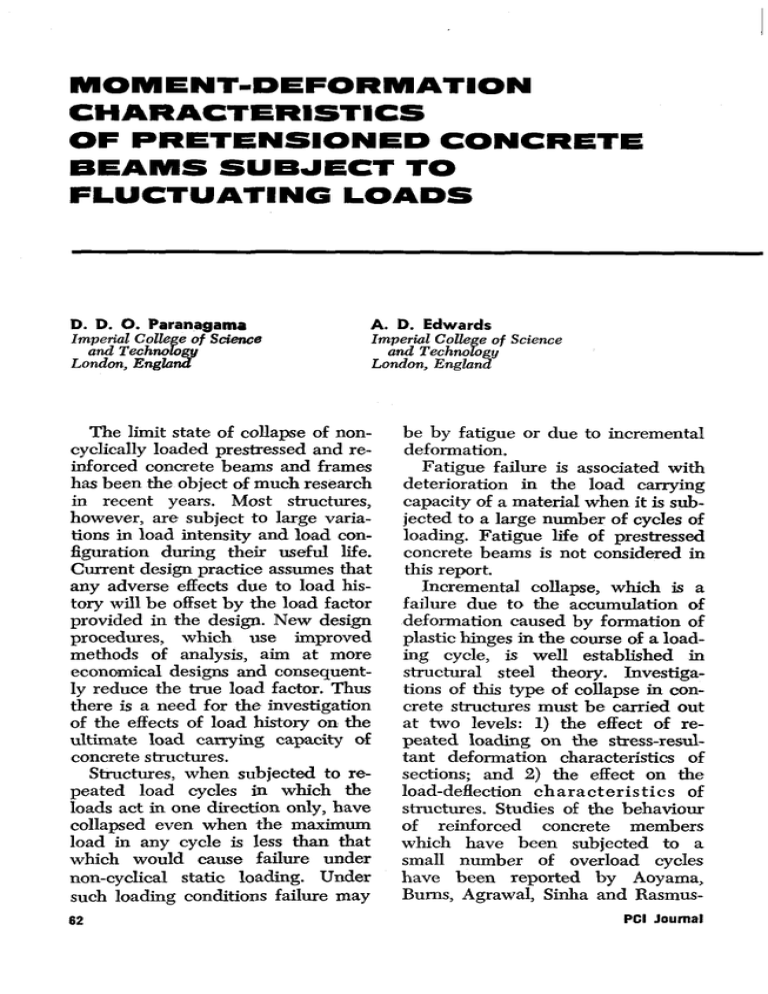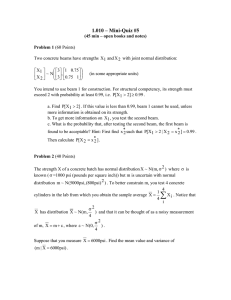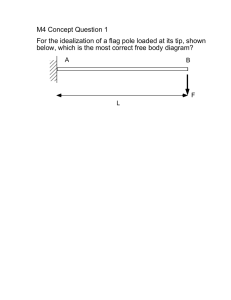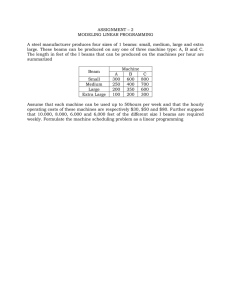to access the full journal article
advertisement

MOMENT-DEFORMATION CHARACTERISTICS OF PRETENSIONED CONCRETE BEAMS SUBJECT TO FLUCTUATING LOADS D. D. 0. Paranagama Imperial College of Science and Technology London, England A. D. Edwards Imperial College of Science and Technology London, England The limit state of collapse of noncyclically loaded prestressed and reinforced concrete beams and frames has been the object of much research in recent years. Most structures, however, are subject to large variations in load intensity and load configuration during their useful life. Current design practice assumes that any adverse effects due to load history will be offset by the load factor provided in the design. New design procedures, which use improved methods of analysis, aim at more economical designs and consequently reduce the true load factor. Thus there is a need for the investigation of the effects of load history on the ultimate load carrying capacity of concrete structures. Structures, when subjected to repeated load cycles in which the loads act in one direction only, have collapsed even when the maximum load in any cycle is less than that which would cause failure under non-cyclical static loading. Under such loading conditions failure may 62 be by fatigue or due to incremental deformation. Fatigue failure is associated with deterioration in the load carrying capacity of a material when it is subjected to a large number of cycles of loading. Fatigue life of prestressed concrete beams is not considered in this report. Incremental collapse, which is a failure due to the accumulation of deformation caused by formation of plastic hinges in the course of a loading cycle, is well established in structural steel theory. Investigations of this type of collapse in concrete structures must be carried out at two levels: 1) the effect of repeated loading on the stress-resultant deformation characteristics of sections; and 2) the effect on the load-deflection characteristics of structures. Studies of the behaviour of reinforced concrete members which have been subjected to a small number of overload cycles have been reported by Aoyama, Burns, Agrawal, Sinha and RasmusPCI Journal The results of tests on eight rectangular pretensioned concrete beams are presented. The beams represent under-reinforced, over-reinforced and balanced design cases. Five beams were subjected to cyclic loading; the remainder were subjected to statically increasing load until failure. An outline of an analytical procedure to obtain the envelope and unloading and reloading characteristics is presented. sen (Refs. 1-6). Corresponding work on prestressed elements has been reported by Abeles(7, ․). SCOPE OF INVESTIGATION The primary objective of the experimental investigation was to determine the effect of a small number of, repeated loadings on the momentdeformation characteristics of pretensioned rectangular beams. Tests on eight beams are reported. Four beams, A l , A2 , A 3 and A4, were of balanced design; two beams, B l and B 2 , were under-reinforced; and two beams, C l and C 2 , were over-reinforced. The first beam from each group was tested statically to collapse. The remainder of the beams were subjected to four cycles of loading at each of four levels of intensity. An ideal program for the investigation would have involved testing a large number of beams, each subjected to the same number of load cycles but having different load intensities applied. Such a program was beyond the time and casting facilities available. The compromise program was restricted in scope to permit any one test to be carried out in a maximum of ten hours. A computer program was written to obtain the theoretical momentcurvature relationship under noncyclic and cyclic loading. The experimental and theoretical results were compared and the latter adjusted to obtain the best correlation. TEST SPECIMENS The eight rectangular preten- Table 1. Concrete strengths Beam Cube strength, psi Cylinder strength, psi August 1969 A, Az A3 A4 B, B2 C1 C2 7900 5065 7800 5500 7600 5550 7460 5100 8210. 5430 8390 5500 7130 4010 6580 3850 63 Table 2. Details of beams Beam A, A2 A3 A4 B, B 2 C, C2 Overall depth, D Width b in. in. 8 6.625 8 6 4 4 4 4 sioned beams were cast in pairs. Concrete proportions by weight were 1:1.2:2.8 with a maximum aggregate size of 3/s in. and a watercement ratio by weight of 0.56. Rapid hardening Portland cement and Thames Valley aggregate and sand were used. Average values of three tests of 6-in, cubes and 6 x 12- in. cylinders, tested on the same day as the corresponding beam test, are given in Table 1. Dimensions, details and reference numbers of the beams are given in Table 2. The longitudinal reinforcement was 0.2 in. diameter indented high tensile steel wire having an ultimate strength of 246,000 psi and a 0.1 percent proof stress of 214,000 psi at a Effec- No. of 0.2-in, tive depth, d wires in. 5.390 5.380 5.440 4.045 Depth Spacing of of stirrups stirrups in. in. 3 3 3 4 6.0 5.5 6.0 5.0 4.5 4.5 4.5 4.5 strain of 0.0087. The shear reinforcement consisted of 1/a in. diameter mild steel bars of 48,700 psi yield stress bent into a square wave form. Initial stress conditions, together with the calculated final prestressing force, are given in Table 3. LOADING APPARATUS AND INSTRUMENTATION The loading frame, the 20-ton Amsler jack, the spring dynamometer loading cabinet and the Solatron data logger are shown in Fig. 1. The test specimen was supported on concrete pedestals by means of a hinge and a roller bearing. Thirty PL 30 electrical resistance strain gauges and twelve PL 60 Table 3. Details of prestress Initial prestress force Ib. wire Final prestress force lb./wire Initial strain in steel in./in. A, A2 A3 3720 3150 0.00335 A4 3720 3000 0.00318 B B2 4800 4100 0.00431 4700 3900 0.00411 Beam C, C2 64 Initial concrete stress distribution (compression is +) psi +37 (^ +253 —250 +940 +11 +1015 [N +6 +1290 PCI Journal gauges were fixed to each beam, together with a number of clinometers and dial gauges, as shown in Fig. 2. In the case of beams B2 and C2, two additional PL 30 gauges were attached to the top surface in line with the gauges on either side of the center line. The load was recorded by means of a dynamometer placed between the beam and Amsler jack. The dynamometer and electrical resistance strain gauges were connected to the Solatron data logger which was operated at two channels per second. TEST PROCEDURE Beams Ai, B l and C1 . These beams were subjected to statically increasing load to failure. The applied load was increased by increments of approximately 15 percent of the ultimate load capacity of the beam until the first crack appeared; thereafter, the load increments were reduced to approximately 5 percent of the ultimate load of the beam. A complete set of readings was taken at each load increment. The duration of the test was about six hours. Beams A2, A3, A4, B2 and C2. Each beam was subjected to sixteen load cycles. Each was first loaded to 60 percent of the ultimate load of the corresponding comparison beam and unloaded completely, except for beam A3 . Four loading cycles were made at this intensity. A complete Fig. 1. General view of test rig August 1969 66 0 . 25L (0.25L- 5) 5 5` (0 .25L-5') 5_ 0.25 L 5~ POD — PL 0 — 19 ?^Q 5— M 2 z^ 2 z" 2 z" 2 z' Section I 2 I 1 q I 1 3' I 2 ^N 3 i" I 3 I 4 Fig. 2. Locations of test gauges set of readings: was: taken on the first and fourth cycle with readings taken at about six stages during both the loading and unloading phases. Readings were also taken at the maximum and minimum load intensities of each load cycle. The procedure was repeated with maximum load intensities of 70, 80 and 90 percent of the ultimate load and the beam was finally loaded to failure. The minimum load intensity of the cycles for beam A3 was 40 percent of the ultimate load of the comparison beam. Each load stage occupied about five minutes. Thus the first and fourth cycle lasted about an hour and the second and third cycles about ten minutes. The total duration of each test was about nine hours. Test on prestressing wire. Three 66 random specimens of the prestressing wire were tested in order to obtain the load-strain curve under repeated loads. Each specimen was subjected to three cycles of loading before loading to failure. The minimum load in each cycle was approximately 4000 lb., the expected effective prestress force in the wires. A complete load-strain history was obtained by measuring load and strain at frequent intervals during the loading operation. THEORETICAL MOMENT -CURVATURE RELATIONSHIP The behaviour of a composite section is. dependent upon the behaviour of component materials, their size and relative positions and strain distribution across the section. PCI Journal The stress-strain relationship for concrete which is subjected to a noncyclic increasing stress was assumed to be parabolic-rectangular. For concrete subjected to cyclic stresses the envelope curve was assumed to be the same and the unloading and reloading curves were assumed to be linear and identical (see Fig. 3). The load-strain curve for the steel was obtained experimentally (Fig. 5) and was. represented by the algebraic expressions given. The normal moment-curvature relationship for the untracked phase was assumed to be linear. The relationship for the phase after cracking was established by a trial and error procedure. In this case a compression strain in the extreme concrete fiber was assumed and the corresponding moment and curvature derived. Since the envelope curve for a section subjected to cyclic loading was assumed to be identical with the normal static loading curve, the reloading curve traced the normal curve once the previous maximum load was exceeded. The unloading and reloading curves were obtained using the following assumptions in addition to those already mentioned: 1. The moment, curvature, j¢, and neutral axis depth at which the change of loading takes place is known. 2. The change of strain in the concrete fibers has a linear distribution across the section. 3. The change in the steel strain, e, corresponding to the incremental change in curvature is given by e8C =F(4 d - z) where F is the strain compatibility factor, d is the effective depth and August 1969 Strain Fig. 3. Stress- strain curve of concrete z is the change in strain in the extreme concrete fiber. 4. The effective modulus of elasticity of the concrete during its loading and reloading cycle is unaffected by its previous cracking history. 5. The concrete fibers in the top of the section can sustain a small tensile stress. Fig. 4 shows typical changes in the strain and stress distributions that are assumed to occur when the beam is unloaded. The following trial and error procedure was used to obtain the unloading and reloading curves: 1. A value was assumed for the incremental change in curvature, 0 1. 2. A value was assumed for the corresponding change in strain in the extreme concrete fiber in compression, z. 3. The change in the total force in the concrete was evaluated. 4. The change in the total force in the steel was evaluated. 5. If equilibrium was satisfied the values in Step 6 were calculated; otherwise a new value for z was assumed and the procedure repeated. 6. The resultant bending mo67 E CA 6C8 Z C YC AYA A \ Ya, Ys L Initial Strain Distribution Change in Strain Distribution l _R // Initial kYA YA1 Final Strain Distribution y^— yB^ final Tc Initial stress Distribution Change in Stress Distribution Final Stress Distribution Fig. 4. Typical stress and strain distributions ment, curvature and neutral axis depth found by this procedure were used as the initial values for the next increment. TEST RESULTS Prestressing wire. The load-strain history obtained from the three specimens is given in Fig. 5. The average modulus of elasticity obtained for the load history shown was E 1 = 30.30 x 106 psi E2 = 29.75 x 106 psi E 3 = 28.00 x 106 psi The envelope of the load-strain curve was represented by 68 P = 947,000 e for 0:€:0.0056 P = 5300 + 94,700 (e — 0.0056) —142,500,000 (E — 0.0056)2 for 0.0056 : e : 0.0087 P = 6900 + 60,250 (e — 0.0087) for e ? 0.0087 Beams. Zero external load condition was taken as the datum for all results. Beam A4 was accidentally reloaded to near failure after the first cycle of loading and the correct history of loading was subsequently applied. The load vs. deflection and load vs. total rotation curves have been PCI Journal d .3 0 0 0 J 2000 4000 bow tuuu Strain x 106 Fig. 5. Load-strain curve for 0.2-in, diameter wire given elsewhere (s). These curves are similar in form to the moment-curvature relationships given in Figs. 6 to 8 where the curvature is based on the strain readings of the appropriate gauges. The curves shown are for the central section of the beam and for sections 1 and 2 in Fig. 2. The envelope and unloading curves for the cyclically loaded beams are solid lines; the reloading curves are dotted as are the curves for the corresponding statically loaded beams. The cycle in which the given curve was obtained is indicated. Residual deflections for beams A2, B 2 and C 2 are shown in Fig. 9. DISCUSSION OF RESULTS Compared to the statically loaded BeamA-----___----------''' 10 , Beam ,^, / 80 o x6 1 3 5 ^ 3 3 Section i Section at y I 400 800 9 / 9 1= 0 / Beam A— A, Section 2 1200 1600 2000 2400 2800 3200 3600 4000 4400 4800 Curvature in' x 106 Fig. 6. Moment-curvature diagram for beam A2 August 1969 69 Beam B^^s----_—-------- ^O 8 x c6 13 5 g 16 Beam B^—^ ^i Beam i // 13 16 5 9 i g 13 5 c 40 0 f y Section 1 Section at 400 800 1200 1600 2000 2400 2800 3200 Curvature in' x 106 Section 2 3600 4000 4400 Fig. 7. Moment-curvature diagram for beam specimens, there is no significant reduction in the ultimate load carrying capacity nor in the ultimate deformation capacity of those beams subjected to the load history specified. The curvature corresponding to the maximum moment in any one set of cycles increases, and the increase per cycle decreases with the number of cycles. The envelope curves for those beams which were subjected to cyclic loading do not vary appreciably from those of the non-cyclic companion beams. The moment-curvature curves for the beams subjected to cyclic loading show that the unloading and reloading paths differ for any two adjacent cycles. The unloading curve has three approximately linear phases: the first phase is relatively short and the beam exhibits a high stiffness which decreases as load intensity increases; in the second and by far the largest phase the beam exhibits a stiffness which decreases as the maximum load intensity to which the beam has been subjected increases; in the third and final unloading phase the beam exhibits a 70 B2 stiffness slightly less than the initial uncracked phase. The reloading path has two approximately linear phases: in the first reloading phase the beam has a stiffness which approximates that of the initially uncracked beam; in the second phase the beam exhibits a stiffness similar to that exhibited in the second phase of unloading. The reloading path crosses the unloading path at moments greater than 90 percent of the maximum load intensity in the cycle. The dependence of the stiffness in the second reloading and unloading phases on the maximum load to which the beam has been subjected is well shown by those curves relating to beam A4 (Fig. 10) which was accidentally loaded to near failure after the first cycle. Subsequent load cycling at 60, 70, 80 and 90 percent of ultimate load did not substantially alter the stiffness in this phase. The above behaviour suggests that the moment-curvature characteristics of a prestressed concrete section are unique. Uniqueness here implies that at any point in the momentcurvature plane there is a unique PCI Journal Im I C E 0 f 400 800 1200 1600 2000 2400 2800 3200 3600 4000 4400 4800 5200 Curvaturerril X 106 Fig. 8. Moment-curvature diagram for beam C2 path which the loading or unloading curves will follow. Sinha, et al have shown that this property is reasonably true in the case of the stressstrain curve for concrete. Similar behaviour has been observed by others for the case of reinforced concrete beams. It is emphasized that such behaviour does not imply that geometrically similar sections of a beam or frame that has been subjected to some loading history will follow similar moment-curvature paths in the same cycle of loading. This is well illustrated in Fig. 7 by the unloading path in cycle 13 for the three sections given for beam B2. The plots of residual deformation against number of cycles, Fig. 9, shows that the residual deformations rapidly tend to a limiting value when the maximum load intensity of the cycles is less than 90 percent of the ultimate load. COMPARISON OF EXPERIMENTAL AND THEORETICAL CURVES Fig. 11 shows a typical theoretical curve obtained by the procedure outlined above. In this case, the August 1969 moduli of elasticity of the steel and concrete and the compatibility factor were kept constant. One result is that the unloading and reloading curves coincide. It is possible to make the theoretical and experimental moment-curvature curves, which correspond to statically increasing load, coincide by varying the value of the compatibility factor. The variation in F required to achieve this for beam B 2 is shown in Fig. 11. It can be seen that F assumes a rather high undefined value when the beam first cracks and then decreases rapidly during the initial stage of the post-cracking phase. Finally F tends to a value close to unity. The theoretical stiffnesses of the beam in the cracked unloading and reloading phase as given in Fig. 11 do not agree with the corresponding experimental values obtained. The parameters which influence theoretical stiffness in the cracked unloading phase are: 1. The value of the neutral axis depth from which the unloading commences. 2. The modulus of elasticity of 71 VIo , X 90%3^o O p C) X X CQ t0 o' 8 0y 0 d d 90 90./ of 1 80% 70° 1 23 4 No of cycles 1 2 3 4 No of cycles 1 2 3 4 No of cycles B2 A2 80°/^ o-- Z2' VIN C2 Fig. 9. Residual deflection vs. number of cycles be expected. A significant change in stiffness in the unloading and reloading cracked phase could only be brought about by varying the compatibility factor. The values of F required in beamB 2 to make the theoretical unloading curves have similar stiffnesses to the experimental curves are shown in Fig. 12. These values are of a similar order to those required to make the theoretical and experimental the concrete. 3. The modulus of elasticity of the prestressing steel. 4. The compatibility factor, F. The influence of the first parameter on the stiffness is negligible as seen in the unloading curves obtained. It was also found that change in stiffness was not significantly affected by varying the modulus of elasticity of both the steel and the concrete over the range of values to Beam A„ 120 Beam A1 -------- `'— _1— \yam' 100 mo 80 x c 60 40 l ice/ 13 5 /i 9 131i / / // ^ 1 i 3 1 o Section at 400 800 1200 q Section 1. 1600 2000 2400 2800 3200 Curvature 3600 4000 4400 4800 5200 in' x 106 Fig. 10. Moment-curvature diagram for beam A4 72 PCI Journal non-cyclic static load curves coincide. CONCLUSIONS 1. The ultimate load carrying capacity and ultimate load deformation capacity of pretensioned rectangular beams subjected to cyclic loading was not significantly different from their capacity under statically increasing load. 2. Subsequent to loading beyond the static cracking load, the unloading and the reloading moment-deformation characteristics can be approximated by a hi-linear relationship; the two stiffnesses are approximately those corresponding to the untracked and the appropriate cracked phases. 3. The stiffness of the cracked phase is governed mainly by the maximum load intensity to which the beam has been subjected during its load history. 4. The decrease in the stiffness in the cracked phase can be attributed to a variation in the compatibility factor since the effect of the other parameters appears to be small. 5. The envelope curve can be reasonably represented by the curve corresponding to non-cyclic increasing load. REFERENCES 1. Aoyama, H., "Moment Curvature Characteristics of Reinforced Concrete Members Subjected to Axial Load and Reversal of Bending Moment," Flexural Mechanics of Reinforced Concrete, Proceedings of the International Symposium, Miami, Fla., November 10-12, 1964. 2. Burns, N. H. and Siess, C. P., "Repeated and Reverse Loading in Reinforced Concrete," Journal of the Structural Division, Proceedings of the 10 LL 5 0 C_ 400 800 1200 1600 2000 2400 2800 3200 Curvature my x 106 3600 Fig. 11. Theoretical moment-curvature diagram for beam B and required variation in F August 1969 73 c 0 Curvature in-' x 106 Fig. 12. Theoretical unloading momentcurvature diagram with varying F for beam B American Society of Civil Engineers, Vol. 92, No. ST5, October 1966, pp. 65-78. 3. Agrawal, G. L., Tulin, L. G. and Gerstle, K. H., "Response of Doubly Reinforced Concrete Beams to Cyclic Loading," American Concrete Institute Journal, Proceedings Vol. 62, No. 7, July 1965, pp. 823-835. 4. Sinha, B. P., Gerstle, K. H. and Tulin, L. G., "The Response of Singly Reinforced Concrete Beams to Cyclic Loading," American Concrete Institute Journal, Proceedings Vol. 61, No. 8, August 1964, pp. 1021-1038. 5. Sinha, B. P., Gerstle, K. H. and Tulin, L. G., "Stress-Strain Relations for Concrete under Cyclic Loadings," American Concrete Institute Journal, Proceedings Vol. 61, No. 2, Feb. 1964, pp. 195-212. 6. Rasmussen, B. H., "Incremental CoIlapse of Ordinary Reinforced Concrete Beams," International Association for Bridge and Structural Engineering, Vol. 16, 1956, pp. 439-456. 7. Abeles, P. W., "Report on Prestressed Concrete Sleepers Tested as Simply Supported Beams," Concrete and Constructional Engineering, Vol. XLII, Nos. 4 and 5, April and May 1947, pp. 123132 and 155-161. 8. Abeles, P. W., "Static and Fatigue Tests on Partially Prestressed Concrete Constructions," American Concrete Institute Journal, Proceedings Vol. 51, No. 12, Dec. 1954, pp. 361. 9. Paranagama, D. D. 0., "Pretensioned Prestressed Beams under Repeated Overloads," thesis submitted for the degree of M. Phil., University of London, 1967. Discussion of this paper is invited. Please forward your discussion to PCI Headquarters by November 1 to permit publication in the February 1970 issue of the PCI JOURNAL. 74 PCI Journal



